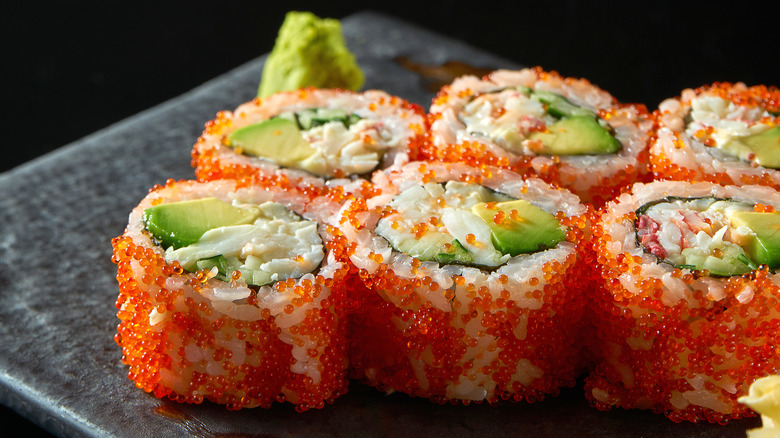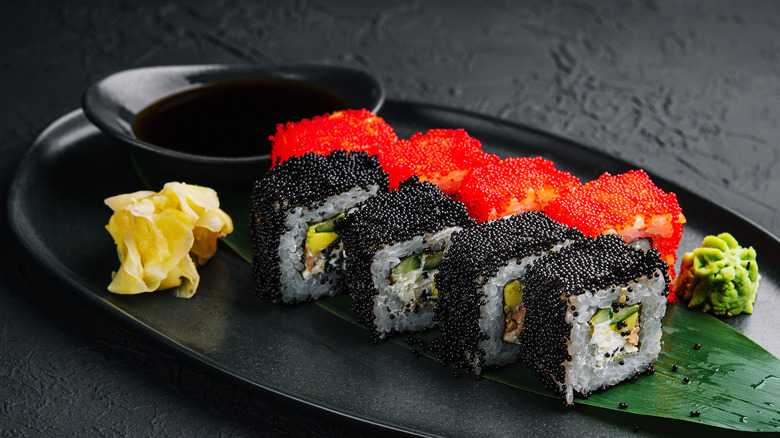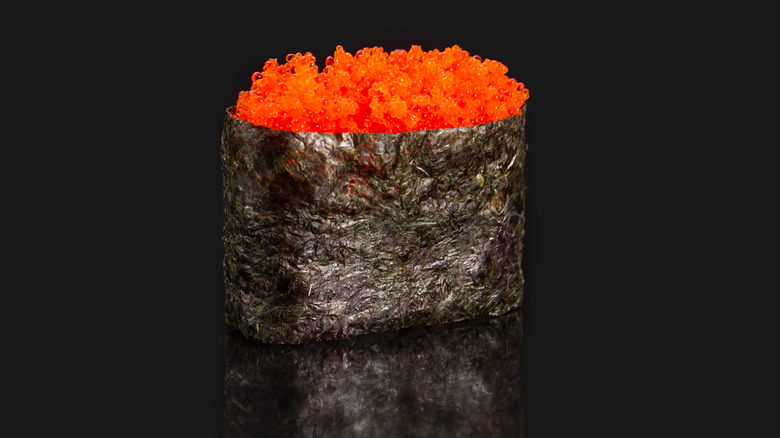What Is Tobiko, The Colorful Japanese Sushi Topper?
Just when you think you know your maki from uramaki, the different uses of gari and wasabi, and the art of dipping sushi in soy sauce topping-side first, out comes a plate of sushi with another colorful ingredient that you still don't know anything about. If you're looking at a piece of sushi studded with shiny translucent balls and wondering whether you've just been served a spoonful of caviar or salmon roe on top of your sashimi or sushi rolls, you haven't. Those bright balls are tobiko.
At its simplest, tobiko is a fish roe, as are caviar and salmon roe. Where caviar comes from sturgeon and salmon roe from, well, salmon, tobiko is the unfertilized egg harvested from the female species of flying fish which are famous for leaping several feet above the water and gliding in the air. These flying fish can be found in the oceans of the West Indies and North Atlantic, but the tobiko used in Japanese cuisine typically comes from Cheilopogon agoo or Japanese flying fish.
Once harvested from the fish, these eggs are then cleaned, cured in salt, dyed in vibrant colors, and preserved in tins until the crunchy little balls are ready to go on top of the sushi on your plate.
Tobiko comes in many colors
While tobiko inherently has an orangish color, that's not the only color it comes in. This is because tobiko is often dyed with natural ingredients which not only give it a whole spectrum of different colors but also affect the roe's flavor. Red-colored roe, for example, can get its bright color from two very different sources. Chefs use either beetroots or chilies to turn the orange roe into a shade of red but depending on the ingredient, red tobiko may have opposing flavors. Tobiko dyed red with beetroot leans on the sweeter side, whereas those infused with chilies will be packed with heat.
Tobiko infused with yuzu will have a yellow tinge and a sour, citrus-like flavor with a subtle zing of ginger. Green tobiko, on the other hand, relies on a mix of mirin, rice vinegar, soy sauce, salt, sugar, and more importantly, wasabi extract for its pungent flavor. There's also a type of tobiko that resembles mustard seeds in appearance thanks to the use of squid ink, which gives it a dark black tinge and a savory umami flavor.
Tobiko can, of course, also be served in its original golden-orange color without any natural ingredients or artificial dyes except for the salt used to preserve the roe, giving it a saline tang.
How tobiko is added to sushi
Tobiko's vibrant shades are a visual treat, but the flying fish roe brings more to sushi than just a bright pop of color. Tobiko has a diameter of no more than one millimeter. But these little fish eggs can still pack quite the punch, especially because they tend to be added in large clusters to make up for the small size of an individual egg.
The process of harvesting and preservation gives tobiko a smoky and briny flavor similar to that of seaweed, which makes it an easy ingredient to pair with seafood, even without the additional ingredients used to dye it. Tobiko's creamy texture gives way to a crisp pop (signature of most fish roe) when bitten into, which is an excellent contrast to the softness of maki or nigiri sushi.
Tobiko can add complexity to a simple piece of sashimi and instantly upgrade sushi salads. It's not uncommon to find tobiko on top of California rolls or sushi salads, either. Often, tobiko is served in the form of sushi that's entirely its own. Known as tobiko gunkan maki, this sushi is made from rice wrapped in nori which is then shaped like a gunkan or boat and topped with a generous scoop of tobiko. Although tobiko doesn't have the strong flavors that warrant it to be eaten on its own like caviar, together with sushi rice, fish, and nori, the flying fish roe can add nuanced flavors to any kind of sushi.



